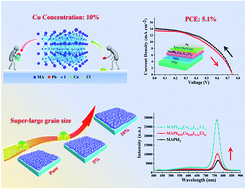3D low toxicity Cu–Pb binary perovskite films and their photoluminescent/photovoltaic performance†
Abstract
Overcoming the toxicity of hybrid organic/inorganic perovskite materials is one of the main challenges to be addressed to deploy their use in commercial optoelectronic devices. Here we demonstrate Cu–Pb binary perovskite films and their integration in solar cells. After doping the MAPbI3 films with a suitable amount of Cu, the crystal structure evolves from twisted tetragonal to cubic. This indicates that the geometric symmetry of the crystal structure improves significantly, a very challenging feat for B-site doping of perovskite films. The improved crystal quality, flatter surface morphology with typical grain sizes up to 2 μm and the six fold increase in photoluminescence intensity are attributed to this change in crystal structure. The blue-shift of emission compared to standard MAPbI3 films can be attributed to Cu doping based on the density-of-states (DOS) results from first-principle calculations and enhanced Pb–I interaction inferred from XPS results. On the other hand, upon doping the n-type carrier concentration decreases by two orders of magnitude despite the improved crystal quality, which is ascribed to the self-compensation of the Cu+ p-type dopant. A power-conversion efficiency of 5.1% with suppressed hysteresis was achieved for MAPb0.9Cu0.1I3−2xCl2x planar solar cells. Overall, doping with Cu reveals surprising effects that can be traced to structural variations that in turn cause changes in properties. These insights are promising towards optimizing the properties of Cu doped MAPbI3 films with reduced toxicity for use in future optoelectronic technologies.



 Please wait while we load your content...
Please wait while we load your content...